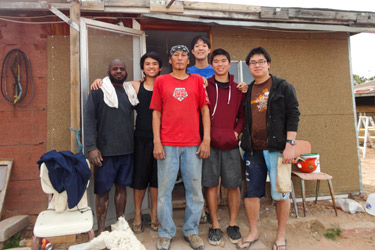Learn More About PUC
PUC Students Return to Navajo Nation
By Giovanni Hashimoto on April 9, 2012
Share this

For many students, spring break means sunny beaches, fun with friends, quality time with family, or maybe just a quiet week of relaxation. For about 19 Pacific Union College students, however, it meant a week of hard work on a service trip to the former Bennet Freeze in the Navajo Nation, near Flagstaff, Arizona.
The trip, which took place from March 23-31, was planned by the Pacific Union College chapter of Project Pueblo, a student-run organization founded at the University of California at Berkeley in 2009. The organization aims to help alleviate the effects of the Bennet Freeze and improve living conditions in the Navajo Nation. This is the second PUC Project Pueblo trip; the first took place over winter break.
“The trip helped people restore their homes after the lifting of the Freeze in 2009,” explained Lorie Johns, PUC’s nursing student success advisor, who accompanied students on the trip. “It’s about supporting people as they are working to rebuild and better their living situation.”
The Bennet Freeze was a federal policy enacted in 1966 prohibiting any building—even basic repairs—on a 1.5 million-acres portion of Navajo territory.The Freeze resulted in decades of crumbling infrastructure in the affected areas and was finally lifted, after over 40 years, by President Barack Obama in 2009. Despite the end of the Freeze, the Navajo people continue to struggle with problems resulting from abandoned uranium mines and coal mining on their territory.
The PUC group split into teams to complete basic construction projects on the homes of three local families. Beneficiaries were chosen by Forgotten People--a community-based organization working on improving living conditions on the reservations--which also partners with Project Pueblo.
Participants came away from the trip having learned as much as they helped. “This trip was definitely very eye opening,” explains Darlene Teddy, a junior environmental studies student. “It allowed me to see the way that the Navajo people still live while we live in an environment where we have running water and electricity--and it let me see the source of our electricity comes from them.”
“A lot of their coal mining, the energy that they make, goes to the larger cities and neighboring states,” she adds. “It makes you kind of realize that we may flip a switch here but the source is over there. The people that are affected over there—we may not think about it but we really should think about how their lives are getting affected.”
Johns agrees. “This trip was an opportunity for us coming from our privileged college background,” she noted. “We come there from different places but going to interact with people of a different culture—living in very difficult circumstances right here in our own country—it was definitely an opportunity for learning and exchange in both directions. It was very valuable in that respect and just as a wakeup call for us to be more aware and more caring about issues that exist right here in the United States.”
Latest News
First Set of PUC’s North Coast Nursing Students Graduate
By Ally Romanes on December 23, 2025
Two Tonge Grants Awarded to M.A. in Communication and Aviation Program
By Marina Maher on December 22, 2025
PUC’s College Days Creates Lasting Connections
By Ally Romanes on December 18, 2025
